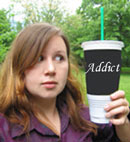
- Press Release
Brand-Name Food Products Also Discovered to Contain Mercury
Institute for Agriculture and Trade Policy (IATP), Jan 26, 2009
Straight to the Source
Minneapolis – Mercury was found in nearly 50 percent of tested samples of commercial high fructose corn syrup (HFCS), according to a new article published today in the scientific journal, Environmental Health. A separate study by the Institute for Agriculture and Trade Policy (IATP) detected mercury in nearly one-third of 55 popular brandname food and beverage products where HFCS is the first or second highest labeled ingredient-including products by Quaker, Hershey’s, Kraft and Smucker’s.
HFCS use has skyrocketed in recent decades as the sweetener has replaced sugar in many processed foods. HFCS is found in sweetened beverages, breads, cereals, breakfast bars, lunch meats, yogurts, soups and condiments. On average, Americans consume about 12 teaspoons per day of HFCS. Consumption by teenagers and other high consumers can be up to 80 percent above average levels.
“Mercury is toxic in all its forms,” said IATP’s David Wallinga, M.D., and a co-author in both studies. “Given how much high fructose corn syrup is consumed by children, it could be a significant additional source of mercury never before considered. We are calling for immediate changes by industry and the FDA to help stop this avoidable mercury contamination of the food supply.”
In the Environmental Health article, Dufault et al. found detectable levels of mercury in nine of 20 samples of commercial HFCS. Dufault was working at the U.S. Food and Drug Administration when the tests were done in 2005. She and co-authors conclude that possible mercury contamination of food chemicals like HFCS was not common knowledge within the food industry that frequently uses the sweetener. While the FDA had evidence that commercial HFCS was contaminated with mercury four years ago, the agency did not inform consumers, help change industry practice or conduct additional testing.
For its report “Not So Sweet: Missing Mercury and High Fructose Corn Syrup,” IATP sent 55 brand-name foods and beverages containing HFCS as the first or second ingredient to a commercial laboratory to be tested for total mercury. Nearly one in three products tested contained detectable mercury. Mercury was most prevalent in HFCScontaining dairy products, followed by dressings and condiments. Attached is the summary list of the 55 products and their total mercury content.
In making HFCS, caustic soda is used, among other things, to separate corn starch from the corn kernel. For decades, HFCS has been made using mercury-grade caustic soda produced in industrial chlorine (chlor-alkali) plants. The use of mercury cells to produce caustic soda can contaminate caustic soda, and ultimately HFCS, with mercury.
“The bad news is that nobody knows whether or not their soda or snack food contains HFCS made from ingredients like caustic soda contaminated with mercury,” said Dr. Wallinga. “The good news is that mercury-free HFCS ingredients exist. Food companies just need a good push to only use those ingredients.”
While most chlorine plants around the world have switched to newer, cleaner technologies, many still rely on the use of mercury cells. In 2005, 90 percent of chlorine production was mercury-free, but just 40 percent of European production was mercury-free. Four U.S. chlor-alkali plants still rely on mercury cell technology. In 2007, then-Senator Barack Obama introduced legislation to force the remaining chlor-alkali plants to phase out mercury cell technology by 2012.
The Environmental Health article by Dufault et al. can be found at: www.ehjournal.net.
“Not So Sweet: Missing Mercury and High Fructose Corn Syrup,” by David Wallinga, M.D., Janelle Sorensen, Pooja Mottl and Brian Yablon, M.D., can be found at: www.iatp.org.
IATP works locally and globally at the intersection of policy and practice to ensure fair and sustainable food, farm and trade systems. www.iatp.org
 HFCS. As scientists learn more about the problems associated with HFCS, more consumers are seeking products with traditional fruit sugars or sucrose table sugar. The ever powerful corn lobby and its associated industry trade groups have responded by launching an aggressive advertising campaign claiming HFCS is as safe as its natural competitors. But new studies confirm previous studies and indicate a diet high in fructose, as compared to glucose, gained more of the dangerous belly fat that has been linked to a higher risk for heart attack and stroke.
HFCS. As scientists learn more about the problems associated with HFCS, more consumers are seeking products with traditional fruit sugars or sucrose table sugar. The ever powerful corn lobby and its associated industry trade groups have responded by launching an aggressive advertising campaign claiming HFCS is as safe as its natural competitors. But new studies confirm previous studies and indicate a diet high in fructose, as compared to glucose, gained more of the dangerous belly fat that has been linked to a higher risk for heart attack and stroke.

